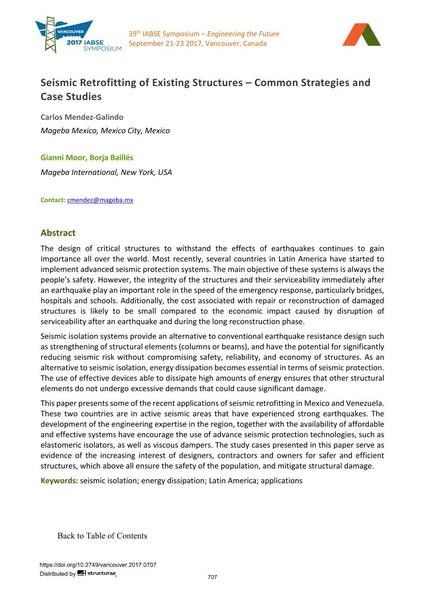Seismic Retrofitting of Existing Structures – Common Strategies and Case Studies

|
|
|||||||||||
Bibliografische Angaben
| Autor(en): |
Carlos Mendez-Galindo
(Mageba Mexico, Mexico City, Mexico)
Gianni Moor (Mageba International, New York, USA) Borja Baillés (Mageba International, New York, USA) |
||||
|---|---|---|---|---|---|
| Medium: | Tagungsbeitrag | ||||
| Sprache(n): | Englisch | ||||
| Tagung: | IABSE Symposium: Engineering the Future, Vancouver, Canada, 21-23 September 2017 | ||||
| Veröffentlicht in: | IABSE Symposium Vancouver 2017 | ||||
|
|||||
| Seite(n): | 707-714 | ||||
| Anzahl der Seiten (im PDF): | 8 | ||||
| Jahr: | 2017 | ||||
| DOI: | 10.2749/vancouver.2017.0707 | ||||
| Abstrakt: |
The design of critical structures to withstand the effects of earthquakes continues to gain importance all over the world. Most recently, several countries in Latin America have started to implement advanced seismic protection systems. The main objective of these systems is always the people’s safety. However, the integrity of the structures and their serviceability immediately after an earthquake play an important role in the speed of the emergency response, particularly bridges, hospitals and schools. Additionally, the cost associated with repair or reconstruction of damaged structures is likely to be small compared to the economic impact caused by disruption of serviceability after an earthquake and during the long reconstruction phase. Seismic isolation systems provide an alternative to conventional earthquake resistance design such as strengthening of structural elements (columns or beams), and have the potential for significantly reducing seismic risk without compromising safety, reliability, and economy of structures. As an alternative to seismic isolation, energy dissipation becomes essential in terms of seismic protection. The use of effective devices able to dissipate high amounts of energy ensures that other structural elements do not undergo excessive demands that could cause significant damage. This paper presents some of the recent applications of seismic retrofitting in Mexico and Venezuela. These two countries are in active seismic areas that have experienced strong earthquakes. The development of the engineering expertise in the region, together with the availability of affordable and effective systems have encourage the use of advance seismic protection technologies, such as elastomeric isolators, as well as viscous dampers. The study cases presented in this paper serve as evidence of the increasing interest of designers, contractors and owners for safer and efficient structures, which above all ensure the safety of the population, and mitigate structural damage. |
||||
| Stichwörter: |
Seismische Isolierung Energiedissipation
|
||||
